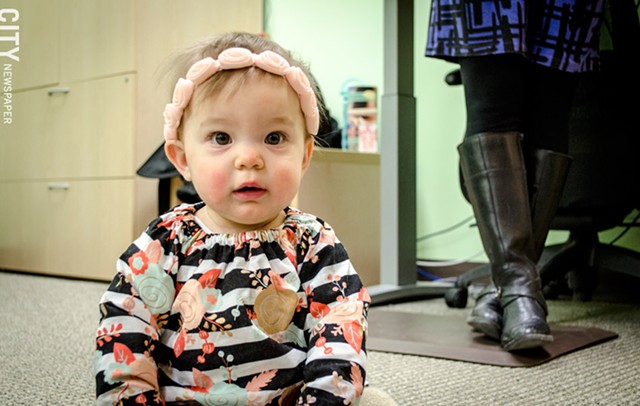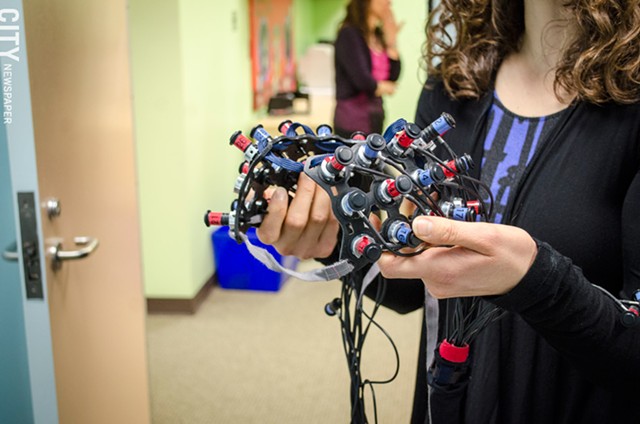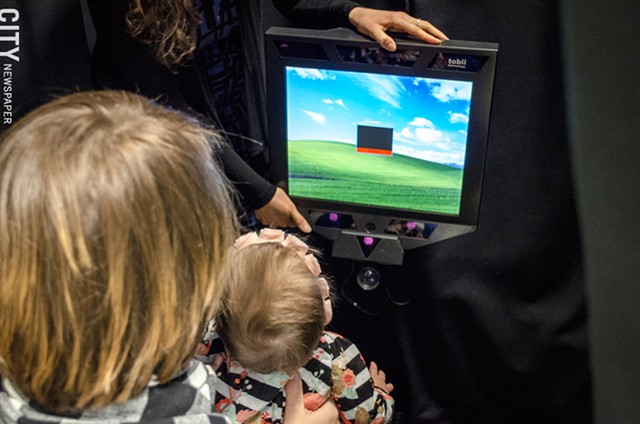Amelia Smith sits on the floor of a newly remodeled wing of the University of Rochester's department of Brain and Cognitive Sciences. The 8-month old wears a headband of cottony roses, and tiny bubbles form in the corner of her mouth. She's completely entranced by the commotion around her.
Though few adults in the room can resist oohing and aww-ing, little Amelia is not there to be fawned over. She's there to work. Researchers at the UR's Baby Lab want to know what she's thinking, what she's learned so far in her young life, and how she learned it.
But there's a problem: Amelia can't talk yet.

- PHOTO BY MARK CHAMBERLIN
- Amelia Smith is participating in research at the UR’s Rochester Baby Lab.
Like her older sisters, Adeline, 4, and Eloise, 5, Amelia is a research participant. She and her mother, Andra Smith, are taken into a small room where they sit together in an area resembling a dark dressing room. It's quartered off with a curtain that looks like a black robe. Directly in front of Amelia is a computer screen.
Lab manager Holly Palmeri, who is on the other side of the curtain, faces a wall of computer screens. The study, which will measure Amelia's attention, begins with Amelia watching a small, red, emoji-like character moving vertically on the screen. The sound of a baby rattle is in the background and as the character continues moving up and down, the rattling switches to a squeaking sound. Amelia doesn't take her eyes off the moving image. She is mesmerized for about four minutes.
When Amelia finally looks away from the screen, Palmeri interrupts the moving character with soft music and starts the program from the beginning. Amelia becomes engrossed again and at one point she gets so excited that she bursts into laughter and reaches for the character. Then she abruptly looks away again.
[image-8]The process repeats several times until it's obvious that Amelia's interest has shifted and that she's getting restless.
Amelia is one of about 15,000 children observed by UR researchers since the Rochester Baby Lab was formed in 1984 by Richard Aslin, a professor and the lab's co-director. On average, most of the children, newborns to 12 year olds, visit the lab one time for each study, he says. Most visits take less than an hour.
The studies can last from three months to nine months.
The lab, with its mix of peach and what Aslin calls toothpaste green walls, is a stark contrast to the rest of the university's psych department, which is decidedly neutral. There's a large playhouse to one side of the room, complete with working windows and a door big enough for children to walk through. It's a major attraction for toddlers and slightly older children.
The lab has little difficulty finding volunteers, Aslin says. Parents of babies born at Strong and Highland hospitals receive a letter shortly after their children are born asking if they'd like to participate in various studies.
Most parents aren't afraid of the research, Aslin says, because at least one parent will be present and there's no diagnostic component to it. Parents are paid a nominal amount for their time.
Safety and privacy are critical to everyone involved, Aslin says.
"All of the experiments, the design, the entire project has to be approved by the Research Subjects Review Board, which operates out of the University of Rochester Medical Center," says Celeste Kidd, an assistant professor, researcher, and co-director of the lab. "It's a government-mandated review board that makes sure that we're behaving ethically."
Andra Smith knew about the Baby Lab because she's a UR graduate and says that she likes the idea of participating in research that may help children.
After Amelia finishes with her part in the study, she returns to the lobby where one of her older sisters is enjoying the play house.

- PHOTO BY MARK CHAMBERLIN
- This cap beams light into the child’s head to map brain activity.
"Really, the hardest part about this whole thing is leaving," Andra Smith says.
Research involving young children is not new. There's always been a subcomponent of the field of psychology interested in early childhood development, Aslin says, and the research is frequently associated with schools of education.
"There were some famous labs in Germany back in the 1800's and there was one at Yale that went on for years in the 1930's and '40's," he says. "But most of that work was done on children who were 3 years old and up, children who could talk."
More than mere curiosity drives the research, he says.
"Imagine you're a parent," he says. "The first thing you want to know is whether your child is normal, whatever that means."
Researchers needed to establish baselines before credible comparisons could be made. But there were no tools to work with babies, Aslin says, other than just watching them.
"If you wanted to understand how kids learned to walk, you turned on the camera and recorded what they did," he says. "To learn how kids acquired language, you turned on a bunch of tape recorders and recorded what they said."
But researchers began to see a gap in childhood development, Aslin says, because babies learn some amazingly sophisticated things much earlier than when they start to walk and talk, which is generally somewhere around 12 months.
"In that first year of life, they are acquiring a lot of information," he says. "But we didn't really understand what they knew."
Although adults tend to take talking and walking for granted, Aslin says, both are monumental achievements in terms of child development.
"There are about 150 muscles in your throat that have to work together in just the right way to produce an intelligible sound," he says. "In order to produce a behavior, you have to have already processed information. You have to learn something before you can control that behavior. It's a pretty complicated thing to acquire."
The same is true for walking, says Michael Goldstein, director of Cornell University's Behavioral Analysis of Beginning Years Lab. He says that for an infant learning to walk, leg strength is a big issue. It's a lot like having a weight connected to a large spring, he says.
"Watch a baby on their back and you'll see them kick," Goldstein says. "And they can do that because there's no weight on them."
The issue isn't which questions researchers want to ask babies, Goldstein says. The challenge is finding ways that babies can answer them. His lab has drawn on Cornell's bird research, which is some of the most extensive in the world.
"It's been really helpful," he says. "There are a lot of similarities between the way birds learn to sing and babies learn to talk."

Breakthroughs in research coupled with advances in technology since the 1990's have led to an explosion in the field of infant research, says the UR's Aslin.
Prior to the 1960's, there were maybe 10 research labs in the world studying infants, he says. Now many major universities have research facilities devoted to some aspect of the field. Sophisticated equipment to track eye movement, heart rate, and brain activity are used in many labs, including the UR's.
Most of the research is funded through grants. UR's baby lab is largely funded through grants from the National Science Foundation and the National Institutes of Health, as well as local and national private foundations, Aslin says.
Research across the field tends to fall into distinct categories.
"There's all sorts of medical research around autism for one example," Aslin says. "There's a lot of work going on right now that involves trying to diagnose autism many months before it is typically diagnosed at around 2 to 3 years of age."
If the diagnosis could occur at around 9 months, Aslin says, it may provide an opportunity for more effective treatment.
Education is another line of research. Aslin and Kidd are particularly interested in how children learn and how their research findings could impact curriculum and classroom instruction.
And Kidd says that there's a huge set of questions out there about how our cognitive system works.
Adults can walk into a house they've never visited, for example, and figure out where the kitchen is located based on previous experiences, she says. They hardly think about it.
"That whole process, we know how incredible it is, but we don't know how we come to have it," she says.

- PHOTO BY MARK CHAMBERLIN
- Amelia sits on her mother’s lap while waiting for the study to begin.
Aslin cites a different example. Longstanding research shows that children from lower-income households receive less spoken language than middle- and upper-income children, he says, and they tend to enter school with a smaller vocabulary or what some educators call a "word gap."
There are efforts around the country to resolve this, Aslin says, but the jury is still out on what works.
Getting at that kind of information is the daily grind for behavioral researchers. And it takes time before those findings can be applied outside the lab, Aslin says, which is exciting and a little frustrating.
"Science moves incrementally," he says. "There are always variables in what we find, but eventually the work moves forward."
During one of the UR's more recent efforts, the research team revisited an earlier study that involved exposing 8-month-old babies to a set of random speech sounds.
"We knew what the underlying structure was, but the babies had never heard it before," Aslin says. The experiment was successful in that the babies were able to learn the new sound structure, he says, but the research team still didn't know how they learned it.
So they revisited the experiment, but this time it involved shining a light into the baby's head.
"If you held a flashlight up to your fingers, your fingertips would glow red, and if you looked in great detail, you can actually see your heartbeat in your finger," Aslin says. "The amount of oxygenated blood in your finger is going to vary with your heart rate. The same thing is true in your brain."
The brain recruits oxygen to areas that are more active, he says. In the experiment, the babies wear a cap fitted with a set of fibers that deliver beams of light to the outer regions of their brains.
The babies look like they're getting a space-age permanent. But the procedure is non-invasive and harmless, Aslin says.
The researchers pair the sounds with a visual, and the babies have to learn this pairing while the researchers assess which regions of the babies' brains are activated. The findings are important because the research shows that babies as young as 8 months have brain function similar to adults.
In simple terms, when sounds are paired with visual stimuli, sound will predict the visual even when the visual has not been presented. The brain is making an assumption based on past experience.
"It's like a signal is going to that part of the brain saying, 'I expect something to be there even when it's not,'" Aslin says.
In another UR study, dubbed "the Goldilocks effect," researchers examined babies' attention patterns using eye-tracking technology. They discovered that babies will ignore information that is too simple and too complex. But they'll tune in when it's just right.
This is important, researchers say, because how babies make decisions about sights, sounds, and movement has broad implications. It could be especially useful to develop tools for earlier diagnosis and treatment of attention-related conditions such as ADHD and autism.
Funding for research is an increasing concern; there isn't as much grant money in the US as there used to be for all of the researchers who need it. And historically, medical research tends to get the big money.
Aslin says that it takes at least $200,000 annually to run a baby lab.
And while the Rochester Baby Lab doesn't have trouble finding volunteers, Aslin and Kidd say that most of the children appear to be from households with middle incomes or higher. They acknowledge that there is some self-selection in their volunteer pool.
"We know there are parents who find it hard to participate because they don't have the time to get here," Kidd says. "They're working jobs that don't allow them to be here. And transportation can be an issue for many."
They're doing outreach at sites such as the Rochester Public Market to increase awareness about the lab and to increase the diversity of their volunteers.
And though they say that they almost never get "guinea pig" complaints from people who may be concerned about how the babies are treated, occasionally some people may not take the work seriously. There is sort of a cutesy nature about the business that usually goes away when people find out more about the lab, Aslin says.
But even with advances in technology and more discoveries, one factor remains constant: babies can't talk. So how reliable is the information gained from the studies?
The UR's Kidd says she believes it's more reliable in some ways than research involving adults.
"I trust infant data more than a lot of adult data in one very important way," she says. "Adults know when they're in a psychology study. And adults are doing all these high-level computations: 'What's expected of me?' 'What should I be doing?'"
Infants don't do that, she says. They're not filtering information.
"If you tell an adult to sit in front of a screen and not give them any further direction, they'll sit there and try to figure out what they're supposed to do," Kidd says. "But infants do one thing exceptionally well, and that's whatever they want."
This story has been corrected.